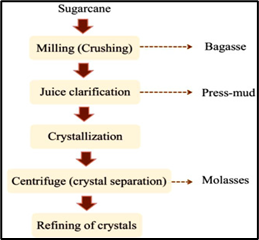Why in News?
- The export of sugar from India has recently been a success story that has received attention.
- Between 2017-18 and 2021-22, these have soared from $810.9 million [6.2 lakh tonnes (lt)] to $4.6 billion (110 lt) and could cross $5.5 billion/Rs 45,000 crore in the fiscal year ending March 31.
What’s in Today’s Article?
- Overview of the Sugar Industry in India
- Where the Sugar Industries are Located in India?
- What Explains the Surge in Sugar Exports?
The Sugar Industry in India:
- Sugar industry is an important agro-based industry that impacts rural livelihood of about 50 million sugarcane farmers and around 5 lakh workers directly employed in sugar mills.
- In Sugar Season (Oct-Sep) 2021-22, a record 359 Lakh Metric Tons (LMT) sugar was produced by sugar mills.
- With this, India has emerged as the world’s largest producer (unseating Brazil) and consumer of sugar as well as the world’s 2nd largest exporter of sugar.

Where the Sugar Industries are Located in India?
- The base of the sugar industry is sugarcane, which is a bulky and perishable crop.
- Since the sucrose content degrades over time, sugarcane cannot be kept for a long period of time.
- In order to provide a consistent supply of sugarcane and reduce transportation expenses, the sugar mills are situated near to the areas where the sugarcane is grown.
- In India, there are two distinct agro climatic areas where sugarcane is mostly grown -
- The states of Maharashtra, Andhra Pradesh, Tamil Nadu, Karnataka, Gujarat, Madhya Pradesh, Goa, Pondicherry, and Kerala are included in the tropical sugarcane region.
- UP, Bihar, Haryana, and Punjab are included in the subtropical sugarcane growing region.
- In 2022, Maharashtra overtook UP to retake first place in India for sugar production.

What Explains the Surge in Sugar Exports?
- Grades of sugar:
- Raw sugar (rough and brownish in colour) is what mills produce after the first crystallisation of juice obtained from crushing of cane.
- Raw sugar is processed in refineries for removal of impurities and de-colourisation.
- The end product is refined white cane sugar having a standard ICUMSA value of 45.
- The International Commission for Uniform Methods of Sugar Analysis (ICUMSA) is a measure of the purity of sugar based on colour.
- The lower the ICUMSA value, the more the whiteness. The sugar used by industries such as pharmaceuticals has ICUMSA of less than 20.
- Much of the world sugar trade is in ‘raws’ that are transported in bulk vessels of 40,000-70,000 tonnes capacity.
- ‘Whites’, on the other hand, are usually packed in 50-kg polypropylene bags and shipped in 12,500-27,000-tonne container cargoes over shorter distances.
- Raw sugar requires no bagging or containerisation and can be loaded in bulk and the buyer here is the refiner, not the end-consumer.
- Where India was lagging?
- Building export markets takes effort since foreign customers must be persuaded of the price competitiveness, product quality and reliability of supplies.
- Till 2017-18, India mainly shipped plantation white sugar - referred to as low-quality whites (LQW) in international markets.
- The Ministry of Consumer Affairs, Food & Public Distribution officials visited Indonesia, Malaysia, South Korea, China and Bangladesh, creating awareness about the quality of Indian raw sugar.
- Comparative advantage to India:
- The refineries in those countries mostly imported raws from Brazil. Brazilian mills operate from April to November, whereas our crushing is from October to April.
- Therefore, India told them to source Indian raw sugar during Brazil’s off-season.
- Also, the voyage time from Kandla, Mundra or JNPT to Ciwandan Port of Indonesia is 13-15 days, compared to 43-45 days from Brazil’s Port of Santos.
- India’s raw advantage:
- Apart from the time window and freight cost savings, Indian raw sugar is free of dextran - a bacterial compound formed when sugarcane stays in the sun for too long after harvesting.
- Indian mills could supply raws with a very high polarisation of 98.5-99.5% (96-98.5% in raws from Brazil, Thailand and Australia).
- Polarisation is the percentage of sucrose present in a raw sugar mass. The more the polarisation, the easier and cheaper it is to refine.
- Outcome of the Indian awareness campaign:
- In 2019, Indonesia agreed to tweak its ICUMSA norms to enable imports from India (previously imported only raw sugar of 1,200 ICUMSA from Thailand - brought down to 600-1,200).
- They even reduced their import duty on Indian raws from 15% to 5%.
- Given how much palm oil India buys from Indonesia, it was like a return favour.











